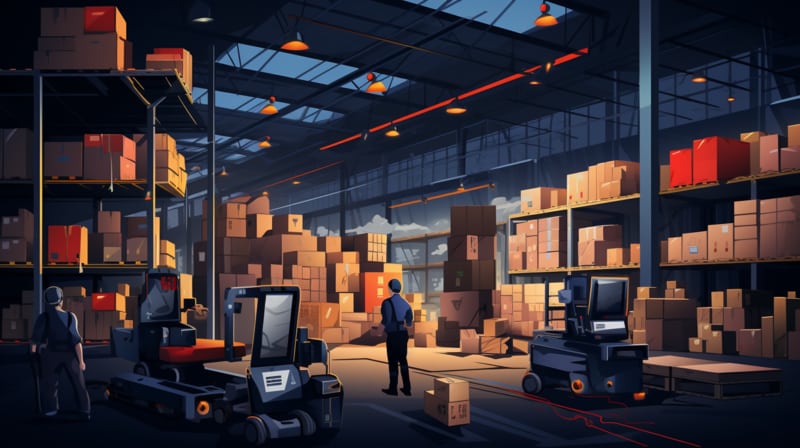SAP EWM Interview Questions
Below you’ll find frequently asked SAP EWM interview answers that may come in handy during an upcoming job interview.
SAP EWM is an efficient warehouse management system which optimises supply chain processes while simultaneously improving performance.
Companies require efficient warehouse management in today’s fast-paced business world toremain relevant.
Beginners as well as experts looking to hone their skills will find our blog of SAP EWM interview questions and answers for experienced invaluable in developing their abilities and passing their exams with flying colors.
Let’s examine some of the more frequently encountered SAP EWM interview questions and their appropriate responses.

1. What is the purpose of warehouse management systems?
The purpose of warehouse management systems is to physically arrange products based on their characteristics, such as temperature and frozen requirements, to optimise space usage and improve efficiency and effectiveness.
2. What is the SAP tool used for warehouse management systems?
The SAP tool manages spaces for various products based on temperature, conditions, and sequential orders.
3. What is the general structure of rows in warehouse management systems?
The general structure of rows in warehouse management systems involves placing products in specific locations based on their characteristics, such as temperature and frozen requirements, to save space and maintain levels for storage.
4. What are the two environments in SAP DWM?
The two environments in SAPDWM are embedded and decentralised systems.
5. Why do companies over embedded systems prefer decentralised systems?
Companies prefer decentralised systemsfor better performance, as they can manage both systems well.
6. What is the difference between products managed in a single location using EWM?
In a single location using EWM, everything is packed in one location, making it easy to understand the differences between products.
However, products cannot be differentiated by product but can be shown inside the packing. The only difference is that the product shown in the image is open and managed by software, which doesn’t provide information about the specific product.
7. What is the role of SAP in replenishment and reallocation?
SAP can be used for replenishment and reallocation, where stock is placed in specific bins after completing the go-down. This process ensures that goods are placed in the correct bins when the stock is finished.
8. What is the overall process of preparing goods, baking them, and preparing them in a warehouse?
The overall process of preparing goods, baking them, and preparing them in a warehouse involves the buyer picking and packing goods, then going to the building and paying the bill. The user then pays the bill and takes the goods. The process of packing and labelling is crucial for the overall process.
9. What is transportation loading, and what are the doors used for in this process?
Transportation loading involves transporting goods from the warehouse to the back area for delivery. The doors used for this process are D1, D2, and D3, which are used for receiving, issuing, and sending goods.
10. What is capital insurance, and how is it used in warehouse management?
Capital insurance is used to assign vehicles to specific positions in the warehouse. The GR doors represent goods issues and are used for shortcuts. Once the stocks are received, they are given to the vehicle data and sent to the back area.
11. What is the concept of storing various products in the staging area, and what are the issues with keeping stock in this area?
When receiving parts from vendors, they will first unload the goods outside or start from the way more. They must arrange the stock in an ample space, with different layouts for each row.
Once the stock is placed in the staging area, it may cause damage if kept outside within one or two hours.
12. What is the role of storage types in warehouse management?
Storage types are determined by the end position, credit identification, and space utilisation system, and they ensure that products are stored in the correct location.
13. What are the two ways of production, and how do they work?
There are two ways of production: finished records production and raw materials consumption.
Raw materials are taken from the production lines in finished records production, and the finished goods are prepared sequentially. The finished goods are then placed in the warehouse.
In raw materials consumption, raw materials are taken from the warehouse to produce finished goods on the production line.
14. What is the process of preparing finished goods in a work centre?
Preparing finished goods involves various steps, including consumption, storage, and packaging.
The company is responsible for packing and shipping the products to the customer. The final goods are then transported to the staging area, unpacked and stored.
The work centre is used for unpacking and packing in the warehouse, with the system identifying stock availability and quantity.
15. What is the difference between a work centre and a staging area?
A work centre is where work happens when receiving and sending goods, while a staging area is where finished goods are unpacked, stored, and await delivery.
16. What is the process of packing in a warehouse?
The warehouse packing process involves counting the packing and determining the order’s creation from a safety or development system.
17. What is the difference between centralised and embedded systems in a warehouse?
Centralised systems have a single server that manages all activities in the warehouse, while embedded systems have decentralised systems with multiple boxes that contain specific activities.
18. What is the concept of operators in a warehouse?
Operators are individuals who manage goods in a warehouse.
19. What is the concept of raw materials in a warehouse?
Raw materials can be procured from vendors or finished by the company. They are an essential aspect of production and management in a warehouse.
20. What is the layout of the warehouse?
The warehouse layout includes a cold handling unit management, a hard zone for hot goods storage, one picking zone for cold goods, a scrap handling area, a packing work centre for hot goods, and a labelling work centre.

SAP EWM Training

21. Why is it essential for companies to maintain a sound stock management system?
Companies must maintain a regular flow of business, whether their product is being sold. They need to order stock from vendors who provide raw materials for their products.
Maintaining a sound stock management system ensures that the company’s stock is managed efficiently and effectively, preventing customers from losing business.
22. What is the GR zone in the logistics process?
The GR zone is a separate zone for frozen goods.
23. What is the goal of the logistics process in the warehouse class?
The goal of the logistics process in the warehouse class is to create a comprehensive system that can handle various users and scenarios.
24. What is the concept of the EWM system based on?
The EWM system is based on every location being a bin, regardless of its role in production.
25. What is the main element of the EWM system?
The main element of the EWM system is the Quality Management (QM) system.
26. What is the role of warehouse numbers in the EWM system?
Warehouse numbers are the highest-level elements in the EWM system, and they are used to identify plant storage locations and manage inventory.
27. What is the difference between decentralised and local warehouse management systems?
A decentralised warehouse is a separate system that manages warehouse operations. In contrast, a local warehouse management system is a subsystem of an ERP system that works inventory and bin-level identification.
28. What is the role of the EWM system in warehouse management?
The EWM system is a precise number, meaning all warehouse operations are managed in a separate system. It is used to manage inventory and bin-level identification.
29. What are the different sections of an EWM system?
The EWM system is divided into several sections: store, bin, door, and work centre.
30. What is the storage type in the EWM system?
The storage type defines the spatial characteristics and characteristics of the bin, such as whether it can be used as a work centre, ID point, or pick point.
31. What is the role of automated guide vehicles in the EWM system?
Automated guide vehicles are resources for the EWM system that assist with picking and moving materials.
32. Can a decentralised warehouse be used alongside other tools like finance, HR, and planning?
Adecentralised warehouse can be used alongside other tools like finance, HR, and planning for more efficient and effective warehouse management.
33. What are resource queues in an EWM system?
Resource queues are a crucial component of an EWM system. They group resources into specific areas and rows to ensure efficient work.
34. What is the activity area in an EWM system?
The activity area is a critical component of an EWM system that drives solidification and assigns tasks to specific users.
35. How do resource queues distribute workloads in an EWM system?
Resource queues distribute workloads based on activity areas by assigning specific users to specific areas.
36. What is the issue with task locking in an EWM system?
Task locking can lead to conflicts and inefficiencies in the warehouse if multiple users are assigned to the same task.
37. How do resource queues address the issue of task locking in an EWM system?
Resource queues can be used to distribute workloads based on activity areas, which ensures better control and efficiency in the warehouse.
38. How is the EWM system logged in and used?
Users can play with the system without needing to configure it once the system is logged in, making it more efficient than traditional configuration methods.
39. How are warehouse numbers defined in the E WM system?
Warehouse numbers are identified, and the system is integrated into the warehouse. Defining warehouse numbers involves assigning sub-matching entities to the warehouse number.
40. What are the different party entries in the E WM system?
Party entries can be different, such as a motor or terminal responsible for managing the stock of two people in one warehouse.
41. How is the supply chain unit maintained in the E WM system?
The supply chain unit maintains the time zone and address of the warehouse, along with the starting point to the ERP to the EWR. The C1 function is used to determine the starting point and technology used.
42. What is the planning process for an EWR system mainly used for?
The planning process for an EWR system is mainly used for a specific purpose, such as inbound and outbound deliveries.

SAP EWM Online Training

The first document in EWM is the IDN or inbound delivery notification notification.
44. What is the role of the TU in the EWM system?
The TU is a packing material treated as a plug within the system, allowing for checking and checking out parking glasses.
45. What happens to the inbound delivery notification in the ERP system after conversion into the inbound delivery?
The ERP system checks the document profile check, default service type, and goods moment bin before converting it into the inbound delivery.
46. How are outbound deliveries created and managed in the E W R system?
Outbound deliveries are created and managed in the E W R system through a S E R P, which splits into multiple orders.
47. What are the primary documents exchanged between ERP and EWM?
The primary documents exchanged between E R P and E WM include the inbound delivery notification and the outbound site, which is converted to the outbound delivery order.
48. What is the role of master data in managing a warehouse?
Master data, including customer, vendor, and material master data, is required to manage a warehouse and distribute data to warehouse operations.
49. What is the main focus of SAP Extended Warehouse Management (SAP EWM)?
SAP EWM efficiently manages inventory, supports goods movement processes, and allows companies to control their warehouse, inbound and outbound processes, and the movement of goods in the warehouse.
50. What are the key features of SAP EWM?
Key features of SAP EWM include setting alerts for changed data before goods receipt, reversing or correcting goods receipt, and inbound delivery splitting.
It also allows for deconsolidation of handling units, executable tasks like work packages, automatic storage concept determination, and tracking vehicles and transportation units from yard check-in to check-out.
51. What is the role of the Warehouse Cockpit in SAP EWM?
The Warehouse Cockpit in SAP EWM allows for a graphic display of warehouse key features and evaluation or monitoring activities using defined chart types.
52. What is the purpose of the warehouse layout?
The primary purpose of the warehouse layout is to optimise warehouse operations and ensure efficient monitoring of warehouse activities.
53. What is the role of function models and user exits in the integration process?
Function models and user exits play a crucial role in ensuring the smooth integration of systems during the integration process.

These are a few multiple-choice questions to gauge your familiarity with SAP EWM.
1. What does the acronym EWM stand for in this context?
a)
b) Enterprise Workforce Management
c) Economic Warehouse Model
d) Enhanced Warehouse Methodology
2. Why do companies prefer decentralised systems for EWM?
a) Better support
b) Lower cost
c)
d) Easier installation
3. In regards to SAP DWM, what cannot be used in a decentralised system?
a)
b) Embedded systems
c) EWM module
d) R
4. Which tool is described as essential for warehouse management systems?
a) ERP Bob
b) DWM
c)
d) Oracle
5. Which type of system receives multiple boxes, like S4 and R?
a) Embedded systems
b) Isolated systems
c) Centrally organised systems
d)
6. What is crucial in the EWM architecture as the highest-level element?
a) Plant storage location
b) Production process
c) Storage bins
d)
7. What advanced features does SAP EWM provide to manage critical activities in a warehouse?
a) Automated customer service
b)
c) Replacing human workers
d) Self-sufficient energy management
This blog covered some of the most frequently asked SAP EWM questions and offers insights for job seekers and professionals who wish to expand their knowledge about this leading logistics and warehouse management solution.
With regular upgrades that keep up with industry developments, SAP EWM remains an attractive solution that keeps organisations competitive within an evolving logistics and warehouse management field.
This blog should help you gain an understanding of SAP EWM and its capabilities.
Good luck in any upcoming interviews!

SAP EWM Course Price


Ankita
Author